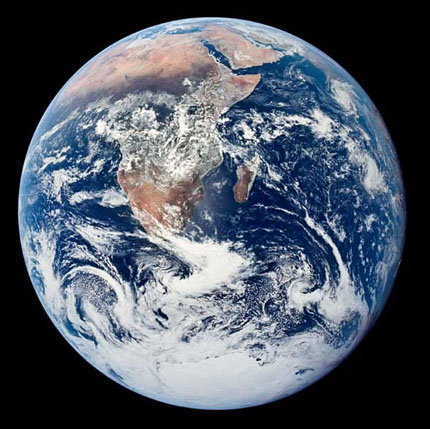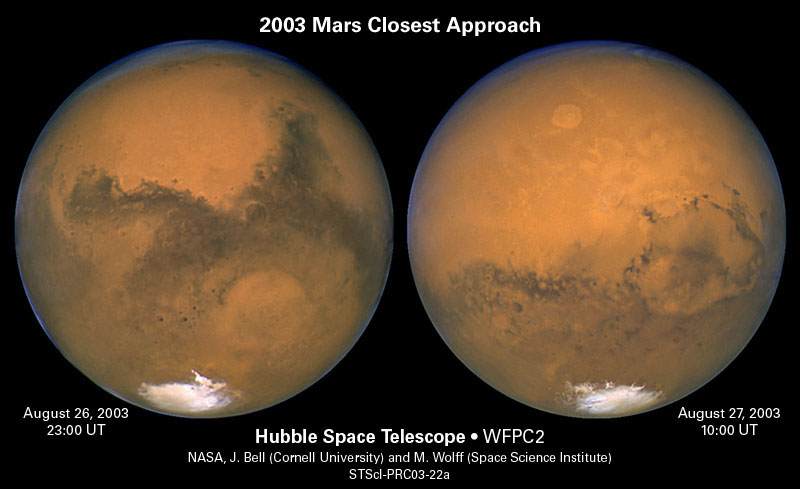
My connection to this topic is that of an artist trying to account for known conditions when creating images of other worlds. Mars was among the first subjects of artists seriously portraying what the other planets might be like. During research supporting his illustrations of the surface of Mars as envisioned in the 1950's in the book 'The Exploration of Mars', Chesley Bonestell was told by leading astronomers at the time that Mars would have a dark blue sky, like that seen in high altitude balloons. He painted them as such, in alluring scenes suggesting American South West desert scenes with most of the atmosphere pumped away. Bonestell lived long enough to paint the skies of Mars as they are thanks to the views captured by the Viking Landers, dusty and bright.
The concept of the sky as a luminous 'shell' surrounding the Earth is visible to one looking about in an unubstructed place outside. The sky overhead is darker due to less atmosphere being looked through compared to near the horizon. This color is also visible from above Earth's atmosphere as a light blue obscuration of the details below, greater as the 'line of sight' passes through more of the air near the 'horizon'. It is a smooth even brightening that the clouds stand out from. Similar effects can be seen along the edges of numerous worlds with atmospheres, and is a clue to the probable 'sky color' to be expected at the lower extremes of the visible atmosphere. Space artist John E. Kaufmann has a presentation of his work on this topic on this page.
Photographs of Mars were 'classically' (before spacecraft were sent there) made through telescopes with black and white film exposed with color filters, preserving color data in separate 'channels' in an analog method of obtaining RGB data. The images of Mars made with the blue filter generally looked very 'bland' with occasional cloud details seen. The best contrast in the planet wide 'markings' are seen in the red filtered photos. Part of this is due to the reduced contrast between the light and dark areas in blue light. When photographed in typically poor resolution the entire atmosphere often appeared to be scattering the blue part of the sunlight, as it does on Earth, (and was part of the reasoning behind the painting of blue skies on Mars by Bonestell and others before the Space Age). Spacecraft studies have revealed that Mars is wrapped with wide patchy regions of high clouds and ground hugging fogs, all brightest in blue light and generally appearing visually light bluish against the the darker ocher planet. There are numerous Hubble Mars images showing cloud formations, some as delicate wide features fading under the noon time Sunlight, others as persistent clouds lasting through out the day. The Mars Global Surveyor image gallery has many images of the planet scanned from orbit in red and blue light. The most revealing image set in this regard is the daily global map data, whose blue images, made at the same time as red filtered versions one can compare to, are often dominated by cloud detail. The clouds of Mars show up best in the blue end of the spectrum, especially over the widespread darker regions. Extensive high cloud formations are generally a superficial 'film' above the bulk of the dusty 'air', and not a property of the main volume of atmosphere as is the suspended dust.

This film image taken of a nearly 'full Earth' during the Apollo 17 mission is shown as a reference for the degree of 'blue sky' brightening seen along the edges, provided by our atmosphere independent of the clouds such as well shown at the extreme left of the image. It is a property of the volume of sunlit air acting as a luminous thin 'skin' which grows evenly brighter when seen near the 'edge' or 'limb', because greater thicknesses of 'glowing' air are seen through. Note the more saturated desert colors on Southern Africa, near the center of the disk and thus being seen 'straight down' through the least amount of atmosphere. Along the upper 'limb' where more luminous day lit air is being 'looked through' at an oblique angle, the colors of the Saharan and Arabian deserts are muted by the light 'blue sky' overlay. This image was chosen to give a reasonable comparison to the Mars images below, also made near 'full' lighting conditions. Attempts to compare the effects of the atmosphere on the appearances of Mars and Earth are best made with non cloudy areas of both worlds. In the case of Earth most clouds are dense enough to show up well on all parts of the visible spectrum. I have adjusted this Earth photo to suggest the probable visible appearance.
Here is, as released, Hubble Mars observations made at the time of closest approach of the planet in late August of 2003, with particular attention paid to accurate color balancing. The 'North Polar Hood' and patches of cloud appear blue and bright against the 'limb' or edge of the disk, but here and there unusually cloud free areas on the Southern hemisphere give an idea of the 'background contribution' of the atmosphere to the 'limb' color.

In practice the suspended dust overwhelms any blue light scattering the bulk of the fairly extended but rarefied atmosphere could provide. Most Martian global cloud features tend to 'dissolve' in midday, appearing denser in the morning and late afternoons. From the perspective of Earth, where Mars appears almost 'full' this often gives the East and West 'limbs' of the 'red' planet a light bluish appearance. At the 'limb', the maximum cross section of these upper clouds are 'looked through', enhancing their presence next to relatively cloud free regions. The clouds can especially be seen in cloudy areas near the Winter shrouded Northern Polar Cap, but they are often absent over the smaller 'ice cap' remnant persisting through it's 'Summer'. Thin veils of cloud over the darkest regions can add a blue appearance to regions like Syrtis Major, the major dark triangular region pointing up from the right side of the left image.
The overall effect along the limb is one of darkening, presumably contributed to by sunlight absorbed by the dust along greater lines of sight on the way to the ground. The setting Sun itself is often dimmed to near invisibility by dust in images from the surface.